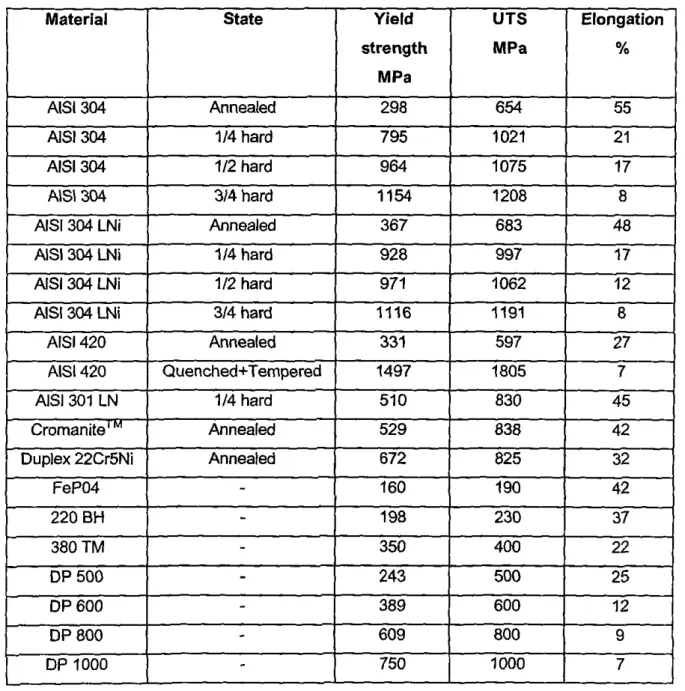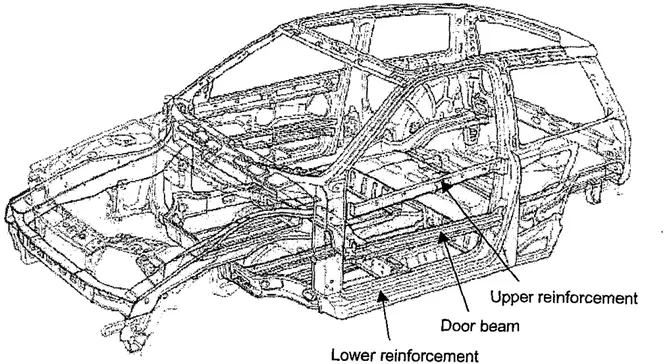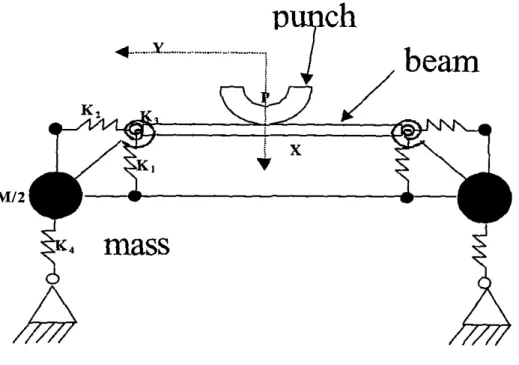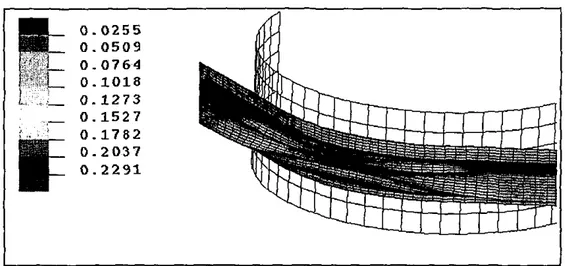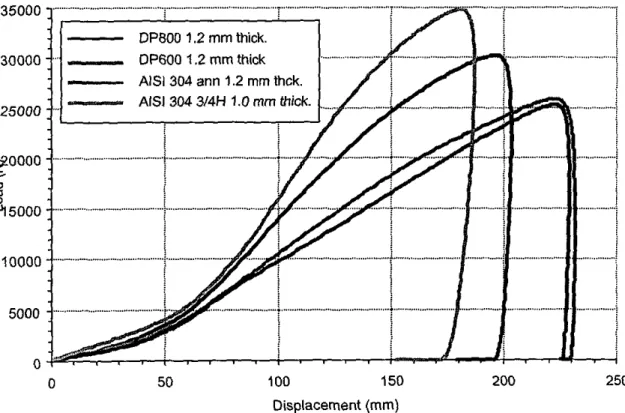NUMERICAL BENCHMARK ON MATERÌAL PERFORMANCE IN ANTMNTRUSION BEAMS
99A4126
T. Coppola, P. Picella, S. Segala, Centro Sviluppo Materiali R. Migliorini, Acciai Speciali Terni
F. Capelli, Centro Inox
Abstract
Passive safety of vehides is increasing by means of solutions based on new design and new materials for structural components. Stainless steels have a strong potentiaf application in crash resistance devices due to their high strength and energy absorption properties. In this paper thè application in side impaci protection devices (door beams) is expfored. A finite efement mode! of an anti-ìntrusion beam, inserted into a sìmpfified scheme ofthe car body, has been set up and used to compare thè materìal response durìng a latera! impaci. Severai materials have been seiected and applied in thè numerìcal simuiations of thè impactr ranging from standard and high strength carbon steels to different stainless steels, includt'ng austenitic, martensitic and duplex grades, both in thè anneaied and hardened state. The materìai response has been studied focusing thè attention on thè safety critetia ruled by thè International standards on car crash testing. The study demonstrated that stainless steels have a wider application range in terms ofyield strength selection, Good formability properties and residuai plastic deformatìons are available in thè component even for thè hardened states. On thè contrary, high strength carbon steels may have some formability problems and low energy absorption capacity durìng crash phenomena. In this case a strong design effort is needed to match thè manufacturìng and performance crìterìa.
1. Introduction
Due to thè increasing requirements for passive safety of vehicles, car manufacturers are continuously developing improved solutions for crash resistance. At thè same time, thè safety requirements must also meet other car design criteria, such as thè lowering of costs and thè body weight reduction. To gain thè target, solutions are studied including thè proper material selection for each component and thè design optìmisation. From some point of views, stainless steels (SS) have appropriate structural crash characteristics, due to their good formability and to thè strong hardening properties. It is possible in fact to balance at best high strength and residuai ductility, as function of thè specifìc application.
Previous works available have been devoted to thè study of crash absorption characteristic of SS in axial impact [1]. Ali these studies have been conducted on experimental basts at laboratory scale. In those cases SS demonstrated great energy absorption properties, due to thè hardening properties and ductility. The aim of this work is to fìnd out if thè same condusìons can be also applied to thè side impact on cars.
2. Standards on side impact testing
The only regulation available for thè full scale side impact testing on cars is from USA. Test characteristics, procedures and evaiuation criteria are collected in thè FMVSS 214 standard. In thè European Community, no officiai standards are available, but studies for regulations are under development. On thè other side, ali car manufacturers have in house procedures for evaluating thè crash resistance, that ali converge on thè generai aspects of thè test (mass of thè impacting vehicle, impact velocity). The final EC document probably will meet thè car manufacturers indication, suggestion and experìence.
It must be remarked thè main point on side impact testing and on fui! scale crash testing in generai. Not only thè structural resistance must be verified, whìch implies thè respect of thè surviving space in thè cockpit (like
indicated in thè US norms), but also thè safety criteria must be satisfied. This implies that thè performance is measured on thè occupant damage, fnvofving limitatfons on accelerations, velocity and forces acting on thè dummies during thè test. The safety criteria are evaluated by comparing thè values of a collection of indexes built from measurements on dummies (velocities, accelerations and forces are measured in several point, as thè head, thè chest and thè pelvis) with specified values, obtained from experience on wounded people,
3. Review of existing door beam design
The beam f'nside thè door is onfy one of anti intrusion devices used for safety during thè lateral crash. Other reinforcements are located in thè floor, under thè door, to absorb in a distributed way thè energy, and in thè upper part of thè door itself. These structures are integrateti in thè door frame or in thè car body, consistìng of box shaped sections. in particular thè under floor structure is devoted to absorb thè distributed load due to thè impacting car, while thè door beam is devoted to avoid thè intrusion in thè cockpit due to concentrated /oads (i.e. corners during not perpendicufar impact). In almost ali thè examined models thè anti intrusion beam consists of round or square tubes. In fig. 1 and 2 some examples of car body structure and anti intrusion devices are shown.
To understand thè design trends, several car models have been selected for a market search on door beams. The most used structures observed in thè analysed car models are single round tube, doublé tube, rectangular closed section and sandwich cìosed omega sectfons.
About thè material used, such data are confidential and not available. The few information collected shows that in generai thè tube types are made by very high strength steels, probably cold worked or heat treated. As an exampie of sheet formed beam, thè rectangular section in SAAB 90 beam is built starting from a high strength carbon steel (CS) sheet. There is one exception, AUDI, which uses in some models an extruded aluminium bar for thè beam.
If we evaluate thè section performance by means of only simple static analysis it can be demonstrated that thè round section is thè less fit to thè purpose and that boxed sections wouìó be preferable, both for bending performance and mass. It must be noticed that, on thè contrary, thè past trend seems to be strongly directed to thè use of round tubes. This fact could be understood as a choice for simple components, even if not optimised for mass. Another indication from thè market is that a more recent trend is appearing to use sheet stamped parts, generally in omega sections, assembleò or not in sandwich.
4. Material data collection on high strength stainless steels and carbon steels
Properties on several SS have been collected to study thè material influence on crash behaviour. The seiected materials are reported in table 1 ; thè delivery state and some mechanical properties are also shown. Together with thè common AfSI 304 and 301, a modified 304 with low Nickel1 content has been evaluated due to its promising characteristics and thè lower cost with respect to thè standard 304. The AISI 420 has been considered for its great resistance in thè quenched and tempered state (QT), which can be achieved on thè fìnaf component by first shaping thè beam and next passing it to thè heat treatment stage. Finally a Duplex (22 Cr 5 Ni) and another austenìtic low nickel steel (Cromanite™)2 have been considered.
For thè comparison between CS and SS, a series of CS have been selected, starting from thè common FeP04 and 260BH, used in thè car body, up to thè high strength CS grades 600; 800 and 1000. In particular grade 600 and 800 are under evaluation by car manufacturers for thè application in specifìc body components and seem now thè most promising choice for increasing thè passive safety. The materials selected are reported in table 1.
Data on mechanicaJ behaviour have been collected for thè above fisted materials in terms of true stress vs true strain curve. In fig. 3, thè direct comparison between CS and SS is proposed. It can be notìced that SS are equivalent or better than CS both in strength and energy absorption, measured by thè area under thè stress vs strain curve. To notice thè SS higher hardening properties in thè annealed state and thè higher elongation to rupture in ali conditions.
5. Finite Element modelling of side impact
1 AJSJ 304 with low Nickel content is under development byAcerinox (E). 2 Cromanite™ is a trade mark from Columbus Stainless Steel (SA).
The anti intrusion beam is inserted into a complex structure, which comprises thè attachments, thè door frame, thè internai door padding, thè car body and thè suspension System. Ali these parts are loaded during thè impact, each one reacting according to its inertia and stifmess. Nevertheless thè study is focused on thè beam, so is more convenient to consider thè car body/attachment System as an invariant and insert in this System different solutions for thè material. The System can be reduced, as a first schematisation, to a chain of elements, which have an associated mass, stiffness and damping. The elements are thè attachments of thè beam to thè door, thè door frame, thè door internai padding, thè door pillars, thè car body, thè suspensions and thè wheels.
The System can be represented by thè simplified dynamic scheme shown in fig. 4. In this scheme, we have thè impacting punch (P) which acts directly on thè door beam. The impact is transferred to thè car body (M) through thè door pillars. The car body is fixed to thè ground through thè suspensions. When deformed, thè door beam can also impact thè internai door structure and transfer thè impact through thè padding, in case of severe intrusion, to thè passenger. So thè occupant is subjected to thè car body pulse, expressed in terms of velocity and acceleration and thè direct impact from thè beam, if case of severe intrusion.
The ki and k2 springs represent thè stiffness of thè door frame and door pillar, M is thè car body mass and thè spring k3 represents thè stiffness of thè suspension System, reduced to a translational degree of freedom. The ki and k.2 spring stiffness can be evaluated on thè basis of standard pillars structures. The vehicle behaviour (1^ spring) can be derived from vehicle dynamic theories, assuming a simplified suspension System. The mass M is of 1000 kg, representative of a mid class car model. The beam is impacted by a mass of 250 kg at an initial speed of 10 m/s. The impacting surface is a rigid punch of 340 mm diameter. Only thè beam is modelled, by using 4 nodes shell elements. A simple geometry has been selected for thè beam section, consisting in an omega shaped section and a spot welded fiat closure (sandwich). The sheet thickness was set to 1.5 mm. The properties collected for thè different materials have been inserted into thè model in terms of true stress-true strain curves. The PamCrash commerciai code from ESI, dedicated to crash analysis, has been used. In fig. 5 an example of finite element result is presented. The deformed mesh of thè beam, with thè equivalent plastic strain plotted, and thè rigid punch are shown.
6. Results and discussion
To evaluate thè beam behaviour and thè material influence on thè System response, it is necessary first to define some evaluation criteria and create a link between thè generai criteria and thè FÉ model results. The door beam behaviour is related to severa! crash safety aspects that can be summarised as follows:
1. To avoid thè door intrusion and thè direct impact to thè passenger.
2. To avoid high accelerations on thè car body, even without direct contact on thè passenger. The acceleration value is related to thè displacement that thè passenger can have, due to inertia, ìnside thè cockpit, with high risk of impact on parts of thè cockpit itself.
3. To reduce thè impact velocity between thè passenger and thè cockpit. For thè same reason described at thè above point, higher is thè maximum relative velocity between thè passenger and thè cockpit, higher will be thè damage due to impact on thè cockpit interiors.
To compare thè different solutions in terms of material performance it is necessary to translate thè safety criteria in measurable quantities calculated by thè simplified finite element model. The numerica! quantities considered as important to evaluate thè beam performance and proposed to measure thè above criteria are:
1. The door beam mid-section velocity at thè time when thè contact with thè passenger is detected (velocity at impact). It is necessary to choose an intrusion distance, which was defined as 152.4 mm. This is thè value for thè maximum deflection derived from thè FMVSS 214 standard.
2. The maximum value for thè acceleration measured on thè point representing thè car body mass (cockpit). The higher thè acceleration, thè higher is thè pulse transferred to thè passenger.
3. The maximum intrusion into thè cockpit. This is a measure of thè beam strength.
The above quantities have been calculated for ali thè material listed in table 1. Data have been elaborated as function of thè material yield point, obtaining thè graphs in fig. 6, 7 and 8. The points have been divided into two families, to represent thè CS (blue) and SS (red) materials. The empty symbols represent a result in which, during thè simulation, thè starting of material failure occurred. The failure criteria is defined accordingly to thè maximum elongation allowable for thè material. When thè limit value is reached inside an element, this is no
more considered in thè calculation. Linear interpolation trends have also been plotted on thè graphs, not considering thè spurious points representing thè material which showed failures.
A strong relationship is visible in thè results. The material properties that lower thè intrusion and thè impact velocity on passenger at thè same time rise thè acceleration transferred to thè vehicle. This generai result suggests an important conclusion about thè design problem of automotive lateral crash: thè problem is not a matter of optimisation. The desired behaviour must be tuned according to safety criteria used and to thè importance given to each single safety aspect. In other words thè car manufacturers could have different goals when designing thè safety devices (i.e.: thè intrusion or stiffness could be more important than accelerations). The main material parameter affecting thè performances is thè yield point. A division in thè two families (CS and SS) could be present, with possibly different trends for CS and SS, showing that thè hardening, even if having some influence, is less important. A limit in thè application of CS seems to appear, with a maximum yield strength applicale of 500 MPa. (t is important to notice that above this strength limit, also formability limitations could arise for thè CS due to thè poor elongation properties. On thè contrary, due to thè higher shaping properties, even in thè hardened states, SS could be considered for thè design of more complex parts, having higher geometrical stiffness respect to sections formed in CS.
The best performances of SS can be also used to reduce thè sheet thickness and thè weight of thè component. Additional simulations were performed comparing DP 600, DP 800 and AISI 304 in thè 1.2 mm thickness and AISI 304 3/4 hard in 1.0 mm thickness. Now thè graph representing thè load on thè punch vs beam displacement for thè four materials is shown (fig. 9). From thè comparison, considering thè penetration (surviving space) and thè maximum load (component structural resistance) as performance parameters, we can say that AISI 304 annealed can be assumed equivalent to DP 600, but with less performance respect to DP 800. Better performances are obtained by using thè VA hard state in 1.0 mm thickness, which also allows a 20% saving in weight.
7. Conclusions
in conclusion, thè following main points can be highlighted. The high strength SS can be a technically valid dioice for crash resistance device applications. In this work thè anti-intrusion door beams have been selected, but thè conclusions are applicable to ali structural components.
The material properties that lower thè intrusion and thè impact velocity on passenger at thè same time rise thè acceleration transferred to thè vehicle, so thè problem of crash resistance devices design is not a matter of optimisation. This means that thè final choice on geometry or material depends on thè car manufacturer design criteria.
The study demonstrated that SS have a wider application range in terms of yield strength selection. Good formability properties and residuai plastic deformations are available in thè component even for thè hardened states. On thè contrary, high strength CS, like DP 800 and DP 1000, may have some formability problems and low energy absorption capacity during crash phenomena. In this case a strong design effort is needed to match thè manufacturing and performance criteria.
An open point remains about thè cost evaluation in an industriai application, which also depend on car manufacturer evaluations.
References
1. H. Groth, R. Johansson, H. Lundth, Energy absorption in stainless steel structural members.
2. Gruber, Hermann, Pitzer, Computer simulation ofside impact using different mobile barrìers, Mercedes Benz AG 1991, SAE paper 910323.
3. Y. Hàland, B. Pipkorn, The protective effect ofairbags and padding in side impacts - evaluation by a new subsystem test method, Electrolux Autoliv and Chalmers, University of Technology, ESV 91 S5 O -06.
4. A. Paluszny, J. Bakkax, State-of-the-art review of automobile structural crashworthiness, American iron and steel Institute, 1992.
5. J.B. Emmons, J. Douthett, Automotive frames of stainless steel, Advanced Materials & Processes, 8/96.
6. FMVSS, A guide to Federai Motor and Vehicle Safety Standards & Regulations, October 1993
7. S. Kelkar, B. Stapel, M. Singri, Dynamic FEA of a door intrusion beam using thè LS-DYNA code, IBEC 96.
Acknowledgements
Work was performed under ECCS support.
Table 1. Materials selected forthe benchmark
Materia! AISI 304 AISI 304 AISI 304 AISI 304 AISI 304 LNi AISI 304 LNi AISI 304 LNi AISI304 LNi AISI 420 AISI 420 AISI 301 LN CromaniteiM Duplex 22Cr5Ni FeP04 220 BH 380 TM DP500 DP600 DP800 DP 1000 State Annealed 1/4 hard 1/2 hard 3/4 hard Annealed 1/4 hard 1/2 hard 3/4 hard Annealed Quenched+Tempered 1/4 hard Annealed Annealed -Yield strength MPa 298 795 964 1154 367 928 971 1116 331 1497 510 529 672 160 198 350 243 389 609 750 UTS MPa 654 1021 1075 1208 683 997 1062 1191 597 1805 830 838 825 190 230 400 500 600 800 1000 Elongation % 55 21 17 8 48 17 12 8 27 7 45 42 32 42 37 22
25
12 9 7Upper reinforcement Door beam
Lower reinforcement
Fig. 1. Example of car structure with passive safety devices for side impact resistance.
2000 AISI 420 O-T
1 5 0 0
-co Q. co 0) ZJ 1 0 0 0 -500 ì AiSl 3O4LNÌ 3/4H AISI 3(M 3/4HAISI 3O4LNÌ I/2HA1SI304 1/2H AIS1 304 1/4H
0.00
•MSI -Oi i/4H Cromanite AISI 3O4LNK ami AJSI 3O4UNÌ I/4H
Dimlex 2205
0.10
0.20True strain
0.30 0.40
Fig. 3. True stress vs true strain curves for thè selected materiais.
M/2
mass
punch
X
beam
0.0255 0.0509 0.0764 0.1018 0.1782 0.2037 0.2291
Fig. 5. Example of finite element result. Deformed mesh and plastic strain distribution.
PEAK ACCELERAT(ON
25 ^ 20-].Ì151
2
5 -• CS• SS
•r
0 250 500 750 1000 1250 1500 Yield strength (MPa)Fig. 6. Maximum cockpit acceleration during impact
4 0 0 350 ~. 300 -£ E 250 -200 -t 150 100 50 -\ I
1
CS SS 2 5 0 INTRUSIONo f
fWF^r
• e -•J£3^ 1 ! 750 1000 1250 1500 500Yield strength (MPa)
IMPACT VELOCITY 7
2" 6
-E """* 5 • 5 4 • o » 3 -2 • 1 0-1 **
| CS• ss
1 1 .JfLfc.B •*
1 1 1 0 250 500 750 1000 1250 1500 Y i e l d s t r e n g t h (MPa)Fig. 8. Beam velocity at impaci against thè passenger (intrusion 152.4 mm)
35000 i 30000 25000 -^ 0 0 0 0 co H5000 100005000 -DP800 1.2mmthick. DP600 1.2mmthick AISI 304 ann 1.2 mm thck. AISJ 304 3/4H 1.0 mm thick. 100 150 Displacement (mm) 200 250
